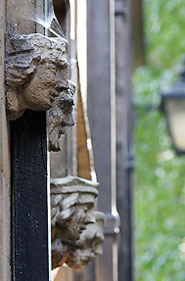Composition
Composition means arrangement which is orderly putting together of part to make a unified whole. The composition can through a personal and intuitive act. Besides, there is no rules to composition, it only guides and extremely flexible principles that may help us to see more sensitively instead of in a hit or miss manner. Thus, we can learn to give form and balance by putting together the elements harmoniously which can help us see a subject in the strongest way through composition.

Rule of Third
The rule of third is the frame that can be divided into three horizontal sections and three vertical sections where the horizontal and vertical lines intersect makes an ideal location for the more important parts of your picture. So, you can give the subject more emphasis than if it was right smack in the middle of the picture. Besides, this is a good technique if have more than one important subject and help to determine how much horizon you want.
 Framing
FramingFraming is the tactic of using natural surroundings to add more meaning to your subject such as bushes, trees, a window, or even a doorway.

Leading Lines
Leading lines are used to lure the eye deeper into a picture or to an important subject. It can be straight, curved, parallel, or diagonal lines. The good examples are the roads, rivers, streams, bridges, branches, or fences which there are endless things that could be used.

Horizontal LinesHorizontal lines is something about a horizontal line in an image that convey a message of ‘stability’ and ‘rest’ such as fallen trees, oceans, sleeping people and so on.

Vertical Lines
Vertical lines can create a variety of different moods in a photograph ranging from power and strength to growth.

Symmetry and Patterns
Symmetry and patterns can be natural and man-made which they can make for very eye-catching compositions, particularly in situations where they are not expected. Thus, it bring a sense of visual rhythm and harmony to photographs that like a series of repeating notes in a melody and also capture the imagination of it. Furthermore, a pattern can appear whenever a strong element of lines, colours, shapes or forms of repeat themselves.



f/8.0 f/5.6 f/2.8
Depth of Field
Depth of field is the amount of distance between the nearest and the farthest objects that appear in acceptably sharp focus in a photography. It varies depending on camera type, aperture and focusing distance. Everything immediately in front of or in back of the focusing distance begins to lose sharpness, even if this is not perceived by our eyes or by the resolution of the camera.
No comments:
Post a Comment